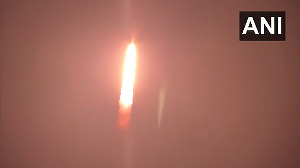Business travelers are some of the best-connected people on the planet. Thanks to BlackBerrys and international cellphones, they can transcend time zones, continents and language barriers.
But airplanes, the most heavily utilized mode of travel for the business set, force them to, well, disconnect.
Use of cellphones has long been forbidden during flights for fear of interference with ground control, and in-flight Internet access is a work in progress. Boeing took a shot at in-flight broadband with Connexion service, but its satellite communication involved a heavy antenna and a $1 million price tag. The aerospace company scrapped the service in 2006.
Slideshow:
Keeping business travelers connected
In pictures:
Tech toys for business travelers
So what's a plugged-in traveler to do?
One company trying to fill the hole Boeing left behind is AirCell. It won an FCC auction in November 2006 for the frequency license to provide exclusive broadband connectivity to US airlines and business aircrafts. It will soon take over the spectrum formerly used by Airfone to deliver air-to-ground phone service.
The airborne telecommunications company will employ an "off the shelf"' technology similar to that used by Verizon and Sprint for data networks and wi-fi hot spots. It can offer the service to airlines for less than $100,000 in equipment costs and sell it to consumers for around $10, says Tom Weigman, senior vice president of Wireless Services for AirCell. Passengers will be able to use laptops and devices for Internet connection and e-mail, corresponding with people on the ground or on another flight.
"Think of it as a wi-fi hot spot in the sky," Weigman says. "On a coast-to-coast flight, you suddenly put somebody through five hours of agony because they can no longer connect and administer their lives and businesses the way they're used to doing on the ground. That's frankly what we're trying to enable them to do."
In pictures:
High-tech hotels for business travelers
High-end, travel-sized toiletries
In talks with several airlines, AirCell anticipates offering the connection in the first quarter of 2008, but aboard an Emirates Airlines' Airbus 340-500, you can already e-mail from 40,000 feet. Emirates launched the service in 2004 by expanding its fleet with A340-500s, which operate between Dubai and New York, Sydney, Melbourne and Beijing, and are pre-installed with wi-fi. Passengers with wi-fi-enabled laptops can monitor their inboxes for a small fee, while sending and receiving e-mails costs more. Or they can access e-mail via onscreen seatback keyboards.
For those who think turning off a cellphone is like temporarily losing a limb, West Sussex, England-based AeroMobile wants to keep you dialed in. AeroMobile's technology permits use of mobile phones and PDAs, including BlackBerrys, in flight. The company uses air-to-ground satellites that include the Inmarsat "Classic" L-band satellite system, which is already installed on most long-haul airliners.
While the FCC prohibits mobile phone use on airborne aircrafts in the US, AeroMobile can operate in the airspace of 30 countries in Europe, the Middle East and Asia. A European Conference of Postal and Telecommunications Administrations report released in December 2006 found that mobile phones on aircrafts equipped with systems like AeroMobile's (a pico cell system) don't interfere with ground networks when operating above 10,000 feet.
In pictures:
How to avoid getting bumped from First Class
Top business deal-making spots
Emirates Airlines has signed on with AeroMobile, though it's still awaiting approval. AeroMobile expects more partnerships later this year.
To keep you from missing out on breaking news while in transit, Virgin Atlantic and Singapore Airlines have installed live text news services. And to help you plan, SeatGuru.com allows you to view the laptop power ports and required adapters on aircrafts before you even board. EmPower DC Power, which needs an adapter, is the most widely installed in-seat power system, used by about 40 airlines, including British Airways' Boeing 777 and Virgin Atlantic's Boeing 747. AC Power simply requires the power supplies that come standard with all laptops--power cord and power brick.
Airspace may be the final frontier, but thanks to these innovations, members of the business world soon won't have to unplug each time they travel through it.






 © 2024 Rediff.com -
© 2024 Rediff.com -